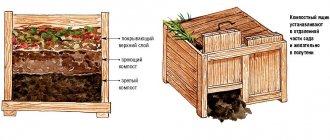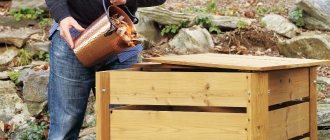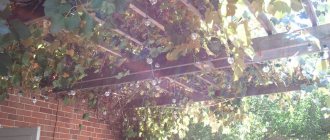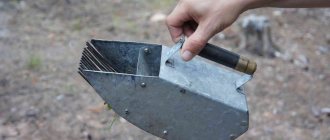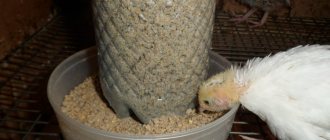It is not difficult to maintain cleanliness and order on a plot of land in winter with the help of specialized small-scale mechanization tools. A well-deserved sense of pride will improve the owner’s mood if he makes a snowblower with his own hands. This creation can be demonstrated to neighbors with an understanding of its own technical and creative superiority. Saving money will be the icing on the cake. Let's try to figure out together how realistic such a plan is.
Even a complex design can be created independently without errors after careful preparation
Operating principle of auger snow blower
Auger snow removal units are divided into two types based on their operating principle:
In single-stage ones, snow is collected and ejected by rotating an auger, which is shaped like the shaft of a mechanical meat grinder. An auger with a smooth edge handles the removal of freshly fallen snow.
Smooth Edge Auger for Snow Blower
In two-stage models, the rotor assists the auger in removing snow. It is attached to the drive shaft. The rotor blades protrude slightly forward, thereby making it easier to grip snow. Rotor blades are made from either metal or durable plastic.
When assembling a snow blower with your own hands, the easiest way is to make it a single-stage one, since this is the easiest unit to manufacture. Its snow throw reaches 10-12 meters.
Features of the package
Snow blowers can be single-stage or two-stage.
In single-stage snow blowers, thanks to the proper operation of the auger, the snow is collected and thrown to the required distance. In its shape, it is similar to the shaft of a food processor for chopping meat, or, as was written earlier, like a corkscrew.
link
Basically, the rotor blade is plastic or metal.
For personal use, both a single-stage and a two-stage cleaning machine are ideal. Your choice should be based on the tasks that the unit will perform. If your city does not have such harsh and snowy winters, feel free to design an auger machine.
For snowier cities, it is recommended to choose the second combination.
Snow blowers are also available in electric and gasoline versions.
Initially, you should decide what kind of snow blower you need - gasoline or electric? Here it is necessary to take into account the amount of future work, because if you are going to remove snow from the footpath and clear the path to the car, then it will be more profitable to build an eclectic model.
It is less maneuverable, but more accessible and profitable to operate.
If you still choose an eclectic motor, please note that the classic electrical cord used in everyday life will lose its technical features at sub-zero temperatures and may stop working. Therefore, we do not advise you to assemble this unit in your own garage from scrap materials, because subsequently it will take you a lot of money and effort to repair it
It’s better to buy a Husqvarna electric snow blower, which costs more, but will last you more than one season.
Therefore, it is recommended to purchase special wires that will not be afraid of frost.
A gasoline unit is suitable if you are cleaning a large area. Once you decide on the type of motor, you should decide on the basis for the future machine - will this unit be built from scratch or will you take an old walk-behind tractor as its basis?
Gasoline snow blower
The second option greatly simplifies the task, because in order to turn this part into a snow blower, it is enough to make the front equipment of a mounted type, which will look like a bucket and auger and will rotate the blades that are mounted on the rotor, while clearing the snow.
Gasoline models are still considered more universal, but the cost of their maintenance and the cost of purchasing parts is much higher. If this doesn’t scare you, then feel free to click here and you can learn how to assemble a gasoline self-propelled snow blower with your own hands.
Calculate all the pros and cons and choose for yourself which type of motor is best for you.
A manual snow blower is exposed to great danger; large or small stones can get into the bucket, as a result of which the engine may stop working. To prevent these unpleasant moments, the design of the unit must be equipped with safety bolts or bushings.
Thanks to them, the auger and rotor will be connected to the drive shaft. If the load has reached the maximum, they will break, but the engine will remain intact.
What kind of engine can be used for a snow blower
If you are going to make a snow blower from a walk-behind tractor, you can skip the engine selection procedure, since the resource of the unit will be used. In this case, you can move on to the next step.
Gasoline snow blower
To make a snow blower you will need an internal combustion engine or an electric motor. For the latter, an extension cord will be needed, which will determine the range of our snow blower. If the action takes place near the house, then it is better to use an electric drive, but you need to remember that the electric motor is afraid of moisture and it needs high-quality waterproofing.
Drive shaft for snow blower
If you need to work in a country house or a remote area where there is not always electricity, then an internal combustion engine running on gasoline is suitable. It can be taken from a walk-behind tractor with low power (6.5 l/s is quite enough). The motor will be mounted on a quick-release platform, which will allow for easier repairs and maintenance in the future.
How does a single stage auger machine work?
A single-stage (auger) snow blower works as follows. As the auger rotates, it collects snow, crushes it and throws it to the side. The edge of the screw has two designs - smooth and serrated. The smooth one works effectively in removing fresh snow, while the serrated one successfully copes with icing. Screw machines are much lighter than rotary screw machines. Essentially, it is a mobile shovel powered by an internal combustion engine or an electric motor. Such machines move using muscle power.
Single Stage Snow Blower
Do-it-yourself snow blower: making an auger and frame
The snow blower consists of a welded metal body, inside of which there is an auger ─ this is the main working element. It is a spiral-shaped profile welded onto a shaft that rotates on bearings. It is necessary to secure the engine to the frame and transmit the rotation of the engine shaft to the auger. A small gap between the auger and the box provides excellent removal of collected snow.
Making a screw with your own hands
In order to make an auger, we need an old box or sheets of iron that need to be bent to the shape of the auger.
Diagram of a screw mechanism for a snow blower
Manufacturing consists of the following stages:
• cut out 4 disks from sheet steel;
• cut the disks in half, bend each disk into a spiral;
• weld four blanks into a spiral on the pipe, on one side and four on the other;
• We put bearings on the edges of the pipe.
You can use any bearings, as long as their internal diameter matches the diameter of the pipe. Glasses for installing bearings are welded into the sides of the snow bucket.
DIY snow blower frame
The frame for a homemade snow blower is obtained by welding 50 mm corners, to the crossbars of which strips for a quick-release engine platform are mounted. It is necessary to attach skids or wheels to the frame to move the snow blower. If the surface to be cleaned is perfectly flat, then wheels are sufficient. For uneven surfaces and deep snow, runners are appropriate.
Do-it-yourself auger snow blower assembly diagram
The controls are attached to the frame with M8 bolts. Next, an easily removable platform is screwed onto which the engine is installed.
DIY snow blower video
Necessary materials
To make a homemade snow blower yourself, you need not only basic knowledge in welding and turning, but also some tools, which are quite difficult to do without.
Here is a list of what we will need:
- Keys of various diameters.
- Bolts and nuts (it is better to collect all available ones to make it easier to navigate in the future).
- Electric drill.
- Bulgarian.
- Screwdrivers of all types and sizes that are in stock.
- Pliers, vices and pliers.
- A regular hammer and file.
- Various chains.
- Welding machine.
Metal pipe for the gutter
Regarding materials, we will need a metal profile pipe with a cross-section of 20 by 40 mm. A profile corner with the same parameters is also suitable for the frame base.
Do-it-yourself snow blower: useful tips
In order for the snow blower to work for a long time and be a reliable assistant for a long time, it is recommended to follow the advice of professionals:
• To prevent stones or ice fragments from entering the engine, it is worth adding safety bolts or bushings to the design. Without them, there is a risk of the engine jamming.
• The choice of bearings plays an important role in the reliability and durability of the unit. They must be closed, otherwise snow may get inside, which will lead to accelerated wear and tear.
• It is better to take a belt drive than a rigid one. Since there is a possibility of jamming of constantly moving parts when large objects or ice hit. The motor may seize, causing the snow blower to break down. In such a situation, the belt will simply slip.
DIY snow blower
By following the instructions and advice of experts and having technical skills, you can assemble the unit, and thereby save on the purchase of equipment. And if the snow blower you assembled with your own hands is also painted, then it will be no different from the one you bought, and its service life and quality of work will be no worse.
Did you like the article? Subscribe to the channel to stay up to date with the most interesting materials
Petrol Engine Snow Blower
Snow removal machines are most often created with a screw or a combined mechanism. The initial stage of work is much easier. For a combined type of snow collector, you need to assemble the kind of rotor that is used in electric models. In this case, the only difference is that the blades are not welded to the rotor body. It is connected to the back of the auger snow blower.
In this case, any air-cooled engine can be used. It can be either two-stroke or four-stroke. The frame of a non-self-propelled device must be placed on skis. It will be much easier for the user to use the machine to collect snow on thick surfaces. If the power indicator allows you to create a self-propelled vehicle, then you need to attach special wheels to the frame, and then combine them through the drive with the engine PTO.
An elegant shoe - a lady's slipper. Acquaintance
Biological features
The rhizome is branched, rigid, shortened. The stems, depending on the species, are 20-50 cm tall. They are pubescent with glandular hairs. In the middle, 3-4 elliptical-shaped sheets with a point at the top are placed in a spiral.
The large inflorescence consists of 1-3 buds, emitting a pleasant, faint aroma of vanilla sweetness. The two lateral petals are narrow and diverge to the sides. The lower one forms a “lip” with a closed cavity inside. The top one is like a lid that covers the “house” from excess moisture and sunlight. The stamens and pistil are hidden in the middle. The color of the petals varies depending on the species: pale pink, bright crimson, yellowish, brownish, white. Sometimes there is spotting. The buds bloom in mid-May. They continue to please the eye for 2-3 weeks. With successful pollination, elongated capsule fruits are formed that ripen by the end of summer.
Pollination method, seed collection
The seed setting process is interesting. Pollination is carried out by small flying insects: beetles, flies, bees. Bright colors and pleasant aroma attract connoisseurs of beauty. In early May, buds appear at the ends of the shoot. After a week, the trap inflorescences open in full glory. The fluttering “elves” sit down on the smooth edge of the “pocket” and slide down the slippery “slide” into the cavity. Trying to get out, they notice two gaps on the sides. They head in the direction indicated by nature, first touching the stigma, fertilizing the flower with the material brought from another specimen. Then they touch the anthers, collecting a new portion of male seed. Not all insects come out of the “trap” safely. By studying plants, biologists found pollinators inside the flower. Predatory yellow myzumena spiders use slippers as bait. They lie in wait for their prey at the entrance, deftly placing nets over the opening. Fertilized specimens quickly wither after 2-3 days. The remaining inflorescences remain fresh for up to 3 weeks. The percentage of seeds set is small. To increase the yield of seed, breeders use artificial pollination using a brush. The grains ripen within 2.5-3 months. In the second half of the period, gauze caps are put on the boxes to prevent the seeds from shedding when fully ripe.
Preferences
The lady's slipper grows well in moderately moist soils under a canopy of tall plants in partial shade. Neutral or slightly alkaline substrates with a light composition are suitable for it. Does not tolerate close occurrence of ground liquid, flooding by spring waters, or lowlands where runoff from rain accumulates. Roots with excessive moisture are affected by rot. Winters well in Siberia and the Middle Zone under natural leaf litter from trees.
Place in the garden
The natural style of the garden is perfect for creating compositions with lady's slippers. Light shading by deciduous trees will appeal to the new resident. You should not place graceful plants under fruit crops. Falls from branches can damage miniature bushes. Low wild grasses will make good neighbors, imitating the natural landscape. In the flowerbed it goes well with hostas, ferns, astilbes, and primroses. Forest orchids are planted next to plants similar to their habitat conditions. Some gardeners cultivate slippers in container planting, changing the composition every year.
Did you like the article? Subscribe to the channel to stay up to date with the most interesting materials
Maybe it’s still better to buy?
When thinking about purchasing such equipment, you should consider several important factors:
| Factor | Description |
| Scope of work | There is no point in buying an expensive device if your plot occupies 12 acres, most of which is a garden. In the garden you only need to clear narrow paths for passage, and a few square meters in front of the house and for parking a car can be easily cleared with a simple shovel. The situation is different if there is a need to clear snow, for example, from the gate to the road in order to drive a car. A large volume of work dictates the need for a snow blower. |
| Available Power Supplies | Snow removal machines can be electric or gasoline. The former can only be used in small areas and subject to an accessible connection. Gasoline self-propelled snow blowers are versatile and have more power. |
| Operator physical capabilities | Snow removal equipment can be self-propelled or non-self-propelled. Even a child can operate the first one, but the second one will require some effort from the operator. Self-propelled devices on caterpillar tracks do not get stuck in snowdrifts and are well suited for areas where the snow cover exceeds half a meter. |
| Device cost | Finished products vary in price depending on the power source and design features. The price of a self-propelled gasoline unit starts from 20 thousand rubles, an electric one – from 6 thousand. |
When choosing a suitable unit, you need to study how to start it, the size of the bucket and engine power
Tip! A large area in the country is best processed with a rotary auger snow blower with a large bucket. It will overcome even large snowdrifts and dense, compacted snow.
Snow blower device
In general, as a rule, all snow blowers have approximately the same assembly. Snow blower parts list:
- Special metal mesh for uniform snow spray
- Bucket with additional stiffening ribs used to strengthen the structure
- Shovel for clearing snow from the impeller, chute and snow bucket
- Special fastening of the gearbox to the bucket for greater strength and reliability
- Toothed metal auger
- Two shear bolts that prevent damage to the gearbox when large objects get into the auger
- Worm gearbox in steel housing with bronze gear to prevent contribution and abrasion
- Toothed auger shaft on bearings for reliable connection and increased rotation speed
- Auger impeller with a special coating that protects against corrosion
- Convenient pads for adjusting the height of the bucket
- Scoring plate
- Unlocking the wheels with a cotter pin
- Tubeless wheels of fourteen inches. They provide high cross-country ability and have clearly defined tread directions.
- Professional 4-stroke engine with overhead valves for better filling of the cylinder with the fuel mixture and a cast-iron cylinder liner that prevents premature wear
- Adjusting the direction of ejection of the chute and the duration of ejection of snow from the operator panel
- Precise weight distribution significantly adds stability to the structure, preventing sideways rollover and strong vibrations
- Controlling the movement of the auger using a trigger
- Adjusting the angle of rotation of the chute to select the desired direction of discharge
- Speed change: 5 forward and two reverse
- Controlling the movement of a snow blower using a trigger
- The halogen headlight will allow you to effectively remove snow at any time of the day.
- Tank capacity of approximately 7 liters will save time on refueling
- 190 degree rotatable metal chute with adjustable top bar for selectable throw range up to 19 meters
Design #2 – “Vyuga” rotary snow blower
This device, quite simple in design, can be made in any workshop equipped with a lathe and a welding machine. The snow blower, designed by Penza craftsmen, performed well even in rather difficult snow conditions.
The design of the device is based on: an engine with a built-in muffler, a gas tank and a cable for controlling the throttle valve.
All components of the device can be purchased in the store or taken from the same motorbike
First, you need to make a rotor on a lathe based on a corresponding blank from an electric motor part. Externally it looks like a steel disk d=290 mm and 2 mm thick. The disk, connected with the help of bolts to the hub, forms a structure to which 5 blades are already attached by welding. To increase the efficiency of the mechanism, the blades are additionally reinforced on the reverse side with stiffeners.
The motor cooling system operates on the principle of a fan, the blades of which are made of duralumin and are fixed on a pulley to start the motor.
The fan is protected by a soldered casing placed on the crankcase cover. To improve cooling quality, the cylinder head is placed at an angle of 90 degrees.
A shaft is mounted on the rotor housing on four ball bearings placed in pairs. It is fixed to the body using a steel clamping ring and bolts. The rotor body itself is pressed against the frame using a special bracket, which partially grips the pressure ring.
Assembly diagrams for the main elements of the Vyuga snow blower
The removable elements of the machine are the aluminum wall of the rotor housing and scrapers located along the frame.
A significant advantage of a homemade snow blower is the ability to adjust the working width by changing scrapers. The quality characteristics of the unit are also excellent. The weight of the structure does not exceed 18 kg, which makes it possible for women to use it, and the snow throw range is about 8 meters.
Design Features
A self-made snow blower can have quite a different design. But in any case, there must be two main parts: collecting snow and throwing it to the right place. Gasoline or electric motors are mainly used as a drive. When choosing the design of a future snowplow, you need to consider how large an area will have to be cleared. The simplest models are not productive enough and do not always cope with clearing thick ice and snowdrifts.
If you need to bring order to a large area, devices with internal combustion engines are an indispensable solution. They are characterized by increased maneuverability and can throw snow mass far.
Despite the significant weight of such structures, there is no need for physical effort to move them. As for non-self-propelled snow blowers, they are most often used to clean up garden paths, sidewalks and flat roofs.
The maneuverability of non-self-propelled vehicles is quite high. But when it is necessary to remove a dense, thoroughly compacted layer, or when there is a lot of snow, or when it is wet, cleaning becomes very difficult. Moreover, the maneuverability of the device also decreases. To compensate for this to some extent, it is necessary to use the lightest possible parts. If preference is given to gasoline models, this is not so important.
Device creation
If you have a walk-behind tractor at home, then it is best to create a snow blower as an attachment. Such a device without a motor is much easier to assemble than a machine on which you will have to create a special stationary drive.
The principle of assembling the screw consists of the following steps:
- The shaft is created from a special pipe, welds on the ends of the journal for bearings, and two rectangular steel plates are placed in the center. These will be the blades of the device.
- Four discs with a total diameter of 280 mm are cut from thicker rubber or steel with a thickness of about two millimeters.
- You can make a hole in the center of each workpiece that will correspond to the thickness of the shaft, after which you need to saw one side of the resulting ring.
- You need to bend a special part from the cut disk and attach it to the shaft. On the left side, several disks are placed with turns directed towards the blades. The same must be done on the other side of the shaft.
You need to attach a bearing number 203 or another suitable size to the axles. To ensure high-quality fastening of the auger, a special hub made from separate parts of the pipe is mounted under the bearing. The blanks are bolted to the side shelves of the snow clearer structure.
The snow receiver bucket is made of sheet steel. To do this, take a strip with a total width of 500 mm and bend it with an arc to a diameter of 300 mm. The sides can be trimmed with metal or plywood. In the center of the upper part of the snow receiver you need to cut a special hole 160 mm), to which a sleeve is attached to throw the snow in the other direction. The finished product is installed on the frame. It is created from the corners of metal.
Now you just need to create a special drive for the snow receiver. That is, you need to make the auger rotate. There are several methods for creating a special drive:
- Some snow blowers can be equipped with a special gearbox. It is installed in place of the blades, and the auger shaft itself is created from two halves.
- The belt drive occurs through two pulleys. One is located on the PTO of the motor, and the second is mounted on the auger shaft.
- The chain drive has the same design as the belt drive, only in place of the pulleys are sprockets from a bicycle or moped.
- If the machine for clearing snow from the site is assembled as a walk-behind tractor or attachment, you need to create a special combined drive. In this case, the shaft will be combined with the intermediate gearbox via a belt drive, and the torque of the gearbox shaft will be transmitted to the auger via a chain drive.
Of all the possible methods, belt transmission is considered the easiest, which is why home craftsmen most often create it for their designs.
When designing a machine with a chainsaw motor, it is very important This model will use a sprocket as well as a chain.
How to do it yourself?
For private use, an electric unit may be the best choice. Very high productivity for putting things in order around the home, next to the garage, and so on is simply redundant. There is no particular difference compared to gasoline mechanisms, except for the drive. But much more differences are found between single-stage and two-stage options. In the first case, the snow mass is pushed out only by the force of a rapidly rotating auger, and in the second, an additional rotor is used. It is the rotary option that is considered preferable, since it reduces the level of wear and avoids various breakdowns. Even if stones or other hard objects get inside, they will not damage the parts of the snow blower.
The auger that crushes the snow is always placed in front, at the bottom of the apparatus. It is certainly covered with a body in the form of a bucket. This solution allows you to redirect the snow mass strictly in a given direction. A modern approach to the manufacture of augers involves the use of high-quality metal, because for this part of snow removal equipment, strength comes first. Externally, the monolithic apparatus resembles a drilling rig or a large threaded screw. When the part is twisted, the snow is crushed and fed inside.
For greater protection of the device, where the auger rotates quickly, a rubber coating is used.
How snow removal machines work
A snow blower for home can be electric or gasoline. The difference is in the way they are powered: the former run on electricity, the latter use gasoline. The structure of a snow blower and the essence of its work look like this. A rotating mechanism collects piles of snow and then pushes it in the desired direction. Based on this, all snow removal equipment is divided into single-stage and two-stage machines. In the first case, the force created by the auger (it has a fast rotation speed) is used for pushing out; in the second case, the rotor is also connected to the work. Such equipment is called rotary snow blowers.
The rotor stands at the entrance of the outlet chute, rotates and pushes out the snow. The auger spins at a much lower speed and therefore wears out much more slowly. An auger is a mechanism that crushes snow and then directs it into the snow blower. You can find the auger in the front of the device. It is usually made of metal and looks strong and monolithic. According to some users, the auger looks more like an enlarged drilling rig or screw. It rotates around its axis, skillfully grinding the snow and feeding it inside.
We also recommend reading
A homemade rotary snow blower is good because it can easily cope even with snowdrifts that are frozen or compacted. For ease of use, manufacturers make the surface of the screw serrated.
The electric snow blower is also equipped with a motor and an outlet chute that regulates the distance of snow throw and its direction. Wheels or tracks can be used as a means of transportation.
Also, all snow removal machines can be divided into self-propelled and non-self-propelled models. The movement can be carried out by a motor (you just direct the mechanism) or by a person.
Snow blower from household equipment - what are the advantages?
Many owners of agricultural equipment often think about converting their equipment into snow removal machines. In this case, the main problem lies in ignorance of the procedure and the fear of damaging existing equipment. However, in practice it turns out that all the fears were simply meaningless, because absolutely everyone can make a snow blower with their own hands. Moreover, the new owner of a homemade car receives several important advantages:
- A self-made unit is much easier to operate and maintain than a purchased model;
- The snow blower consumes much less fuel compared to store-bought counterparts from well-known manufacturers;
- Homemade snow blowers are much lighter and smaller than household store-bought snow blowers.
A big plus is the short time required to manufacture a snow blower. After spending about half a day, you get a reliable unit that will allow you to quickly remove snow without much physical effort.
Operating principle of a two-stage machine
A two-stage (rotary auger) snow blower works as follows: the auger rake in the snow, and the rotor throws it out through a special chute. The augers in these snow blowers can be smooth or serrated. It is permissible to make them from metal or from other materials, for example, reinforced rubber. This equipment can be either self-propelled or manual. The rotor impeller can have from three to six blades. Polymers or metals are used for their manufacture.
Two stage snow blower
The given snow blower diagrams are not very technically complex, and it is quite possible to make them yourself.
Snow blower from a trimmer - anyone can do it
One of the simplest options for making snow removal equipment is to use a household trimmer and a small list of additional materials. The power of the manufactured unit will directly depend on the characteristics of the trimmer motor. However, even a machine with low power can easily cope with snow removal in small areas.
Homemade snow removal equipment in most cases consists of a trimmer and a shovel. The distance for throwing snow masses is small, however, this, as a rule, is not of particular importance for owners of suburban real estate. The main advantages of the unit include low noise level, excellent maneuverability and ease of maintenance.
The manufacturing process itself takes approximately 3–4 hours. During operation, you should carefully ensure that no remaining snow gets into the engine, as moisture can damage the trimmer motor.
At the end of the winter period, the shovel is removed and grass mowing attachments are installed instead.
Making a snow blower: getting started
Prepare a welding machine, drill and grinder for metal in advance. You will also definitely need sheets of roofing iron and steel, pipes of various diameters, angles, bearings and bolts, a separate square and metal clamps, plywood.
- Decide in advance what type of snow removal equipment you would like to make: auger or auger-rotary. The second option is somewhat more complicated, but in heavy snowfalls its effectiveness is much higher.
- Perhaps the main part of the manufactured mechanism will be the auger. It is a drive shaft to which the “cutting” rings are securely attached. The shaft is made from pipe with a diameter of 3/4 inch. The length is exactly the same as the length of the bucket. Trunnions are welded to each end. In the future, they will allow you to install the shaft in bearings.
- If you are planning to build a two-stage snow thrower, a metal plate measuring 12 x 27 cm is attached to the center of the pipe. Its key task is to transport the snow into the chute. Rings 10 mm thick, made of conveyor belt, cling to the sides. You can also cut them from 2mm thick sheet steel.
- To make a bucket, it is best to take roofing iron. The bucket will close the auger on three sides at once, and the upper part will move forward a little.
- The side parts of the bucket can be made of plywood 10 mm thick. Of course, this is not a DIY snow shovel, but you can be sure that the plywood will hold up. Self-aligning bearings with a built-in shaft and auger are placed on the sides. 2 cm - this is exactly the distance from the edges of the spiral. The main thing is that the auger does not cling to the bucket. A hole is necessarily cut at the top for the outlet chute. To make it, you can use a piece of sewer pipe (diameter 15 cm or more). The pipe bends at the top, setting the desired direction for snow to fall.
- To easily remove and service the engine, take care to build a special frame for installation. Metal corners will come in handy. Weld metal strips to the frame to secure the bucket with auger and motor. Drilled holes will allow you to install wheels and a handle.
- Skis and wheels are the next stage of production. To help your snow blower move properly, you can use wheels or skis. The second option is preferable - snow is snow. Skis are made of metal and attached like a sled. The distance from the frame should be minimal. If you decide to install wheels, make sure that they have the maximum level of grip and are resistant even to very severe frosts.
- Since you and I make manual snow blowers, they must have their own handles. The snow blower design involves installing handles from half-inch diameter pipes. It is most convenient to secure them with bolts. When moving the snow blower, you should be comfortable and comfortable doing so. A snowplow is not a tractor, and it certainly won’t move on its own.
- A few words about the rotor. It doesn't matter whether you make a snow blower from a trimmer or use any other method. But in a two-stage design, an improved rotor can be made instead of a screw. It looks like an axis around which 4 rectangular plates are fastened. It is desirable that they have rims on the edges - this will improve snow collection. Make sure that the diameter of the rotor exactly matches the diameter of the bucket and does not hit it.
- A homemade electric snow blower can be equipped with a simple 1 kW electric motor. The main thing is that it is isolated from water and snow - you don’t want to observe a short circuit, right? The same goes for the power cord. There should be no damage to it.
- There are two ways to connect the motor to the shaft: a gearbox and a belt feed.
Thus, a typical DIY snow blower is equipped with an electric motor, a separate bucket with an auger, an outlet chute, a frame with special handles and a wire. You can use skis or wheels as a supporting mechanism. As for the screw, it can be manufactured according to various principles. This has already been discussed above.
Snow blower made from a gas cylinder - simple about complex things
This kind of homemade snow blower will not require large financial outlays. At the same time, you will have to work hard to saw the gas cylinder. The main thing before making the unit yourself is to make sure there is no gas and pressure in the container.
The advantage of using a gas cylinder is that it makes it possible to obtain a very durable shovel, which, even when hitting hard obstacles, will not deform or break.
In addition to the cylinder, you will also need to use a home cultivator and a walk-behind tractor, the motor, rotor and belt of which will drive the auger mechanism of the snow blower.
Assembling the machine will take no more than 2–3 hours. Ready-made snow removal equipment is very easy to use and does not require frequent repairs.
Snow blower from a lawn mower - the essence of the conversion
This kind of homemade snow removal machines for the home with your own hands makes it possible to regularly clean small areas with a flat surface. The main advantage of these units is efficiency, maneuverability and low noise level. Before making a snow blower, you will need to study the drawings, which indicate the gaps between the elements and the markings of suitable fasteners.
It should be remembered that a lawn mower is a unit that is not intended to work in winter. Therefore, during the manufacturing process of a snow blower, it is necessary to ensure reliable protection of the unit’s engine. Steel plates or plastic linings do this job well.
Types of snow removal equipment for the home with your own hands
Snow removal machines are designed for mechanical removal of snow cover in the required area. Their functions include collecting snow mass and throwing it back to the collection point. The engine that powers the car can be electric or gasoline. And the snow removal equipment itself is divided into self-propelled (with tracked or wheel drive), manually controlled, single-stage and two-stage.
To independently assemble such garden equipment, you can use a chainsaw engine, an electric motor or a walk-behind tractor, as well as various improvised materials that everyone probably has on their farm. Before you make a snow blower with your own hands, you should familiarize yourself with the types of such equipment and choose an acceptable option for yourself.
The choice of snow blower design depends on many factors, one of which is the area of the area that is supposed to be processed.
Electric snow blowers can clear small areas near your home, such as porches or narrow walkways. Such a unit is not suitable for clearing large areas of snow cover. In addition, its operation is not effective if there is ice or significant snowdrifts. On the other hand, such equipment is quite compact, easy to operate and convenient to store.
Gasoline-powered self-propelled snowblowers do an excellent job of removing large amounts of snow from large areas. Moving independently, these vehicles have excellent maneuverability and a long ejection range. The equipment is quite large in size, but does not require any physical effort during operation.
Before you make a manual snow blower with your own hands, you need to keep in mind that non-self-propelled models are designed for cleaning small areas of freshly fallen snow up to 25-30 cm thick. They are mainly used for daily cleaning of sidewalks, garden paths and flat roofs. Such devices are quite maneuverable, however, when removing a dense layer, it will be difficult to control the equipment, since you will have to push not only the device, but also the thickness of the snow in front of it.
DIY snow blower with a chainsaw engine
Helpful advice! When assembling a non-self-propelled snow blower for your home with your own hands, you should use the lightest possible parts, since the equipment will work due to human efforts.
Chainsaw snow blower - a unit for simple tasks
The advantages of such a machine include light weight and modest fuel consumption. At the same time, the machine can easily cope with servicing territories of up to 5 acres. The essence of manufacturing is to disassemble the chainsaw, remove its engine and gearbox, and install the parts on a homemade unit. For the manufacture of the bucket, auger plates and nozzle for throwing snow, steel sheets with a thickness of at least 3 mm are used.
The finished snow blower throws snow masses at a distance of up to 2 meters. The machine is very easy to operate, maintain and repair yourself. Among the disadvantages, the high level of noise and vibration should be highlighted.
Snow blower from a cultivator - for power lovers
This option has such advantages as fairly high power, cross-country ability and snow throw range. At the same time, such a unit consumes a large amount of fuel and makes a lot of noise during operation.
It is important to remember that the cultivator is not designed to work in severe frost conditions. In this regard, the engine of a homemade snow blower must be regularly warmed up before you start clearing snow. In order to protect the motor, the machine body will need to be equipped with protective metal plates.
A snow blower made from a cultivator can be used in large areas, up to 15 acres. When operating, use high-quality seasonal motor oil. At the end of the winter period, the bucket and auger mechanism can be dismantled and the cultivator can be assembled for tillage.
Useful tips
Finally, we present to your attention some useful tips on the manufacture and operation of snow removal equipment; they will help your product last as long as possible without complaints or failures:
- in order to prevent ice or stone fragments from getting inside the structure, in particular into its drive mechanism, it is advisable to add specialized safety bolts or bushings to its structure;
- One of the main working elements of a snowplow is its bearings, which largely affect the service life of the product against failure; in this regard, you should carefully select this design element, monitoring the quality of its execution;
- it is advisable to give preference to a belt rather than a rigid transmission for the simple reason that there is a high probability of jamming of moving structural elements as a result of ice or stones getting into them;
- snow removal equipment designed on the basis of a walk-behind tractor must be kept warm - by following this simple rule, you will save yourself from wasting precious time and equally precious fuel on warming up the engine before starting to operate the device;
- do not forget about the need to periodically change the oil for the gear mechanism; in winter, the oil should be thinner, since in low temperatures it can thicken quite quickly.
